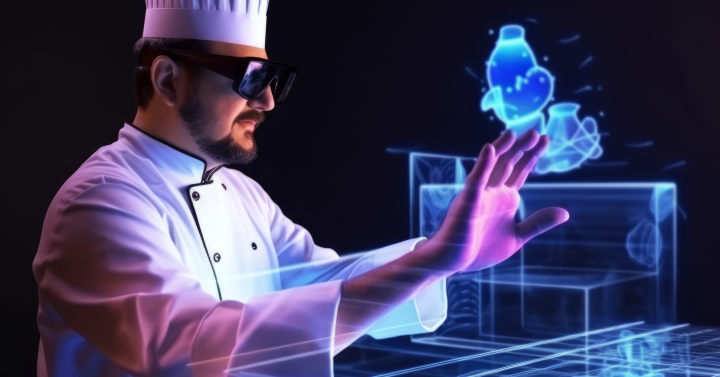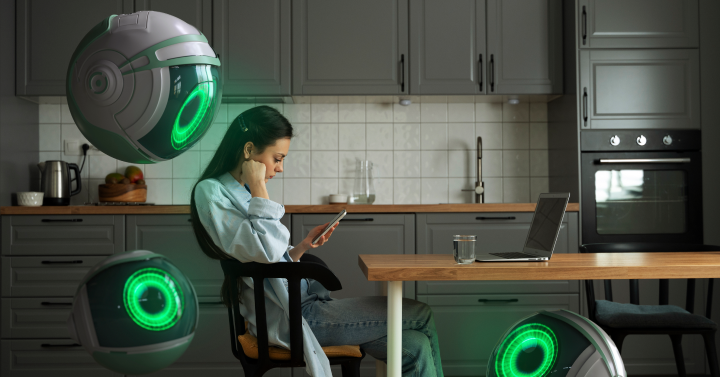We build digital products to help businesses succeed!
Introduction
Revolutionizing the dining experience, AI Conversational Bots in Food Service are making a significant impact. But what impact are they truly making? As per Gartner, by 2027, chatbots will become the primary customer service channel for roughly a quarter of organizations. In the food service industry, this statistic is brought to life by AI chatbots. These intelligent AI Conversational Bots in Food Service are no longer confined to answering simple queries; they now handle complex tasks, from personalized order taking to resolving customer inquiries.
According to a McKinsey analysis, artificial intelligence (AI) technologies have the potential to generate up to $1 trillion in added value annually, with a major contribution coming from improved customer service. Deloitte goes on to say that the market for conversational AI globally, which includes chatbots and intelligent virtual assistants, is anticipated to increase at a compound annual growth rate (CAGR) of 22% from 2020 to 2025, when it will have reached roughly US$14 billion. This blog explores how AI conversational bots are revamping the food service experience, making it more efficient, personalized, and engaging. Stay tuned as we delve into the world of AI-powered dining.

Why Do AI Conversational Bots in Food Service Matter?
Let’s delve deeper into each benefit of AI Conversational Bots in Food Service and understand their importance in the food service industry:
1. Streamlining Order Taking with AI Bots:
Efficient order processing is a hallmark of AI bots. When a customer interacts with a chatbot, it can quickly understand their preferences, dietary restrictions, and desired items. This efficiency reduces manual errors that might occur when human staff take orders. Unlike human staff who have working hours, AI bots are always “on.” Customers can place orders at any time, whether it’s during peak lunch hours or late at night. This availability enhances convenience and customer satisfaction.
2. Enhancing Customer Queries:
AI bots can provide immediate answers to common queries. For instance, a customer can ask about allergens in a specific dish, and the bot can instantly retrieve accurate information from its database. This responsiveness ensures a seamless customer experience. Bots can also maintain consistency in their responses. Whether a customer interacts with the bot during breakfast or dinner, they receive the same accurate details about menu items, promotions, or delivery options.
3. Improving Service Efficiency:
During busy hours, long wait times can frustrate customers. AI bots handle multiple queries simultaneously, minimizing delays. Customers appreciate the promptness, especially when placing urgent orders. Routine tasks, such as confirming reservations or collecting feedback, are automated by bots. This frees up human staff to focus on more complex tasks, improving overall service efficiency.
4. Revolutionizing Customer Experience:
AI bots can remember customer preferences. If a regular customer interacts with the bot, it can recall their favorite dishes, dietary restrictions, and past orders. This personalized touch enhances the overall dining experience. Natural language processing allows bots to engage in friendly dialogues. Instead of rigid, scripted responses, they can adapt their tone and style to match the customer’s communication style.
5. Real-Time Assistance:
If a customer wants to modify an order or inquire about delivery status, the bot can assist promptly. This responsiveness builds trust. Based on a customer’s preferences (gathered from previous interactions), the bot can suggest menu items. “How about sampling our just introduced vegetarian pasta?” It’s similar to the dish you enjoyed last time.”
6. Personalized Customer Interactions:
Bots can maintain profiles for frequent customers. These profiles store information like dietary preferences, allergies, and feedback. When the customer returns, the bot can tailor its responses accordingly. They can subtly recommend additional items. For instance, if a customer orders a pizza, the bot might suggest adding garlic bread or a dessert. This not only enhances the customer’s experience but also boosts revenue.
7. Automating Order Processing:
Seamlessly integrating with POS systems, AI bots automate order entry and payment processing. When a customer places an order, the bot automatically enters it into the system, calculates the total, and processes payment. Manual order entry can lead to mistakes like incorrect quantities or wrong items. AI bots minimize such errors, contributing to overall operational efficiency.
AI conversational bots in food service play a pivotal role in transforming the food service industry by providing efficient, personalized, and seamless interactions.

Real World Examples of AI Conversational Bots in Food Service Industry
- Domino’s Pizza: Domino’s AI chatbot, “Dom”, is a prime example of how AI Conversational Bots in food service can enhance the customer experience. Dom is designed to understand natural language, which means customers can place their orders just as they would in a real conversation. This includes complex orders with multiple toppings, different crust styles, and additional sides. Dom can also suggest add-ons based on the customer’s order, providing a personalized experience. Moreover, Dom can track your delivery in real-time, keeping customers updated about their order status.
- Starbucks: Starbucks’ AI chatbot, “My Starbucks Barista”, takes customer service to the next level. Customers can place their orders via voice command or messaging, making the ordering process seamless and convenient. What sets My Starbucks Barista apart is its ability to recall past orders. This means if a customer frequently orders a particular item, the bot will remember this and make it easier for the customer to reorder their favorite items.
- Burger King: Burger King’s chatbot is integrated with Facebook Messenger, allowing customers to place an order directly through the platform. This makes the ordering process incredibly convenient, especially for customers who are already using the platform. The bot also uses location data to provide the nearest pickup location, adding another layer of convenience for the customer.
- Chipotle: Chipotle’s AI chatbot, “Pepper”, is designed to handle a wide range of tasks. Not only can Pepper take orders and process payments, but it can also provide nutritional information about menu items. This is particularly useful for customers who have dietary restrictions or are trying to make healthier choices. In addition, Pepper can handle catering orders and group orders, making it a versatile tool for both individual customers and larger groups.
- McDonald’s: McDonald’s AI chatbot, “McD”, is more than just an ordering tool. While it can answer customer queries and provide nutritional information, it can also help with job applications. This shows how AI Conversational Bots in food service can be used for a variety of purposes, not just customer service.
These examples illustrate the diverse ways in which AI Conversational Bots in food service are being utilized for various functions. As technology continues to evolve, we can expect to see even more innovative applications of these bots.
Conclusion
AI Conversational Bots in food service have emerged as game-changers. From streamlining order processes to enhancing customer interactions, these digital assistants have revolutionized the dining experience. As we savor our favorite dishes, behind the scenes, AI bots seamlessly handle reservations, provide real-time assistance, and personalize recommendations. Their impact extends beyond efficiency; it’s about creating memorable moments for patrons.
Whether you’re ordering a pizza or seeking allergy information, these bots ensure consistency, accuracy, and convenience. As the food industry embraces this technological shift, we witness a fusion of culinary artistry and digital innovation. So, the next time you chat with a friendly bot while placing an order, remember that it’s not just about food—it’s about the future of service, one conversation at a time.
Offices
India
86P, 4th Floor, Sector 44, Gurugram, Haryana 122003Singapore
#21-02, Tower 2A, The Bayshore condo, Singapore 469974Canada
8 Hillcrest Avenue Toronto ON M2N 6Y6, CanadaUS
31 River CT, Jersey City, New JerseySubscribe to our newsletter
Our Services
Top Reads
India
86P, 4th Floor, Sector 44, Gurugram, Haryana 122003
Singapore
#21-02, Tower 2A, The Bayshore condo, Singapore 469974
Canada
8 Hillcrest Avenue Toronto ON M2N 6Y6, Canada
US
31 River CT, Jersey City, New Jersey
Contact us
info@primathon.in
+91-9205966678
Reviews


